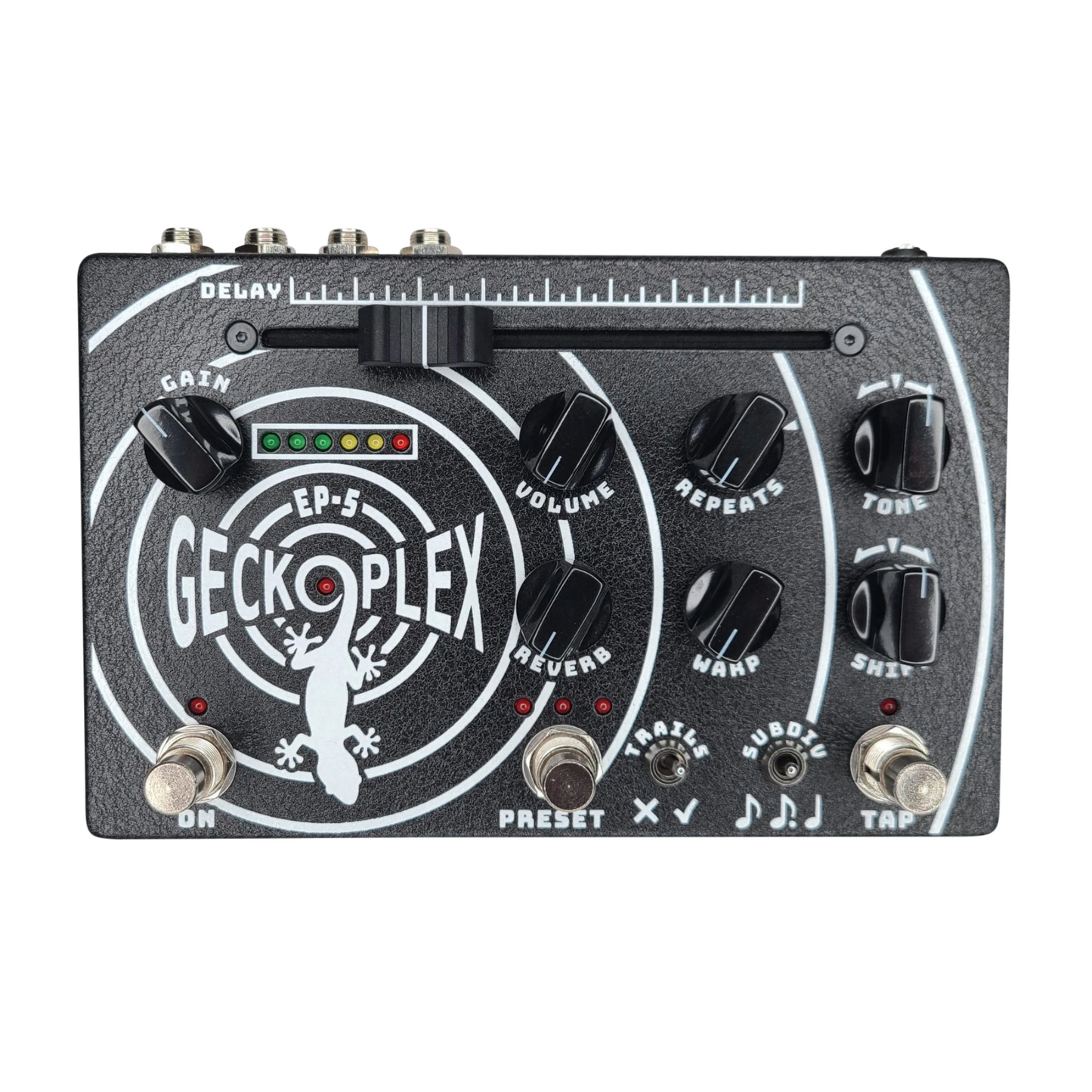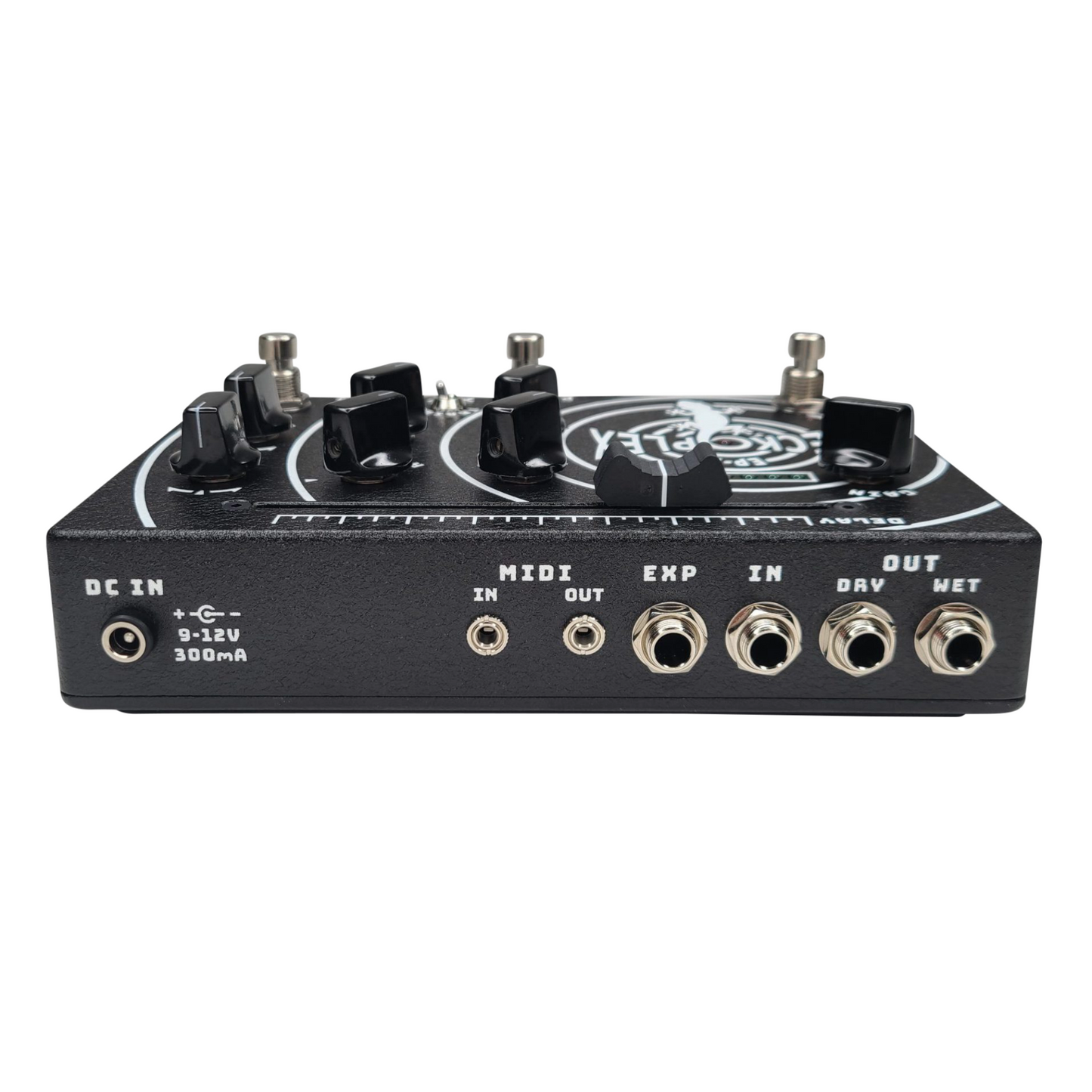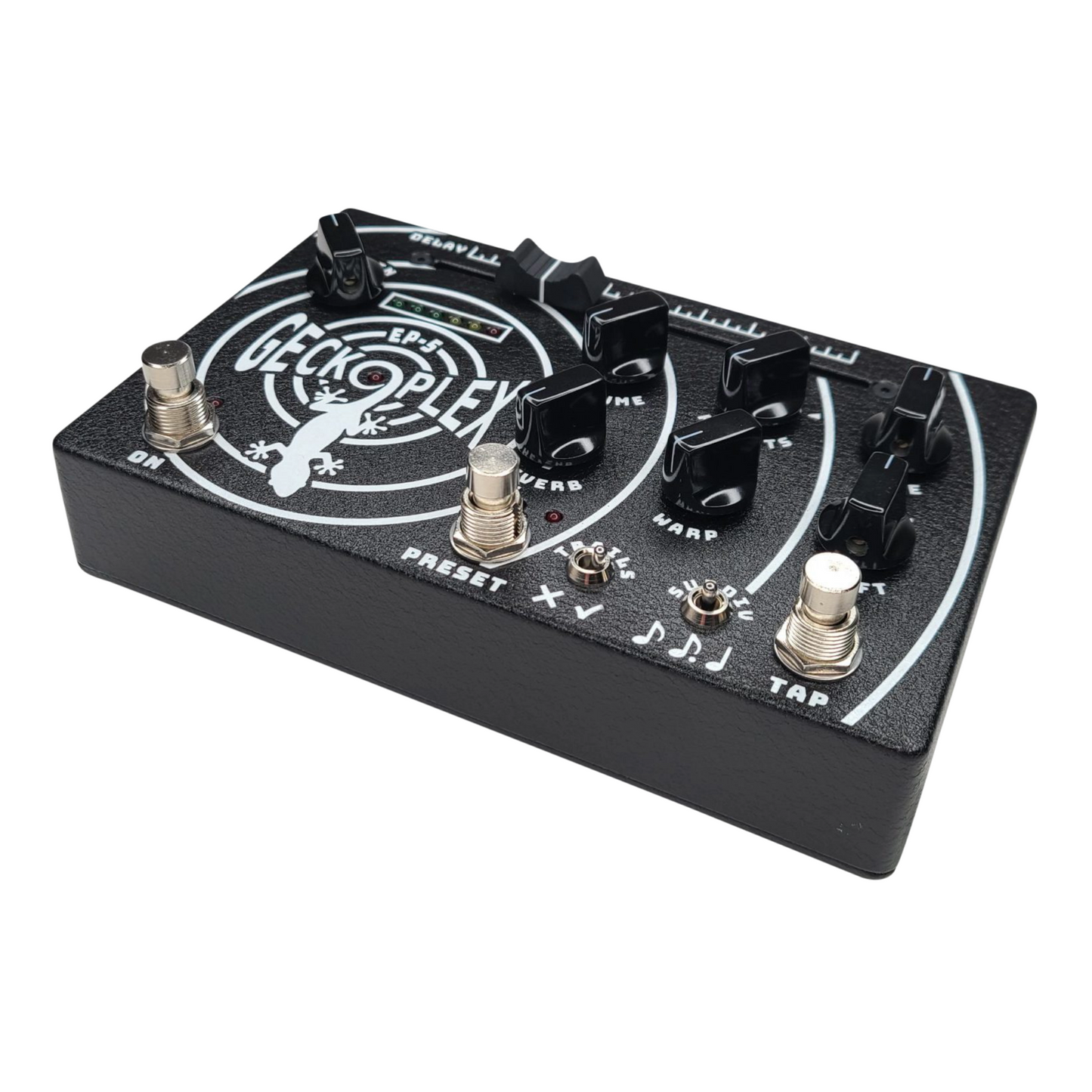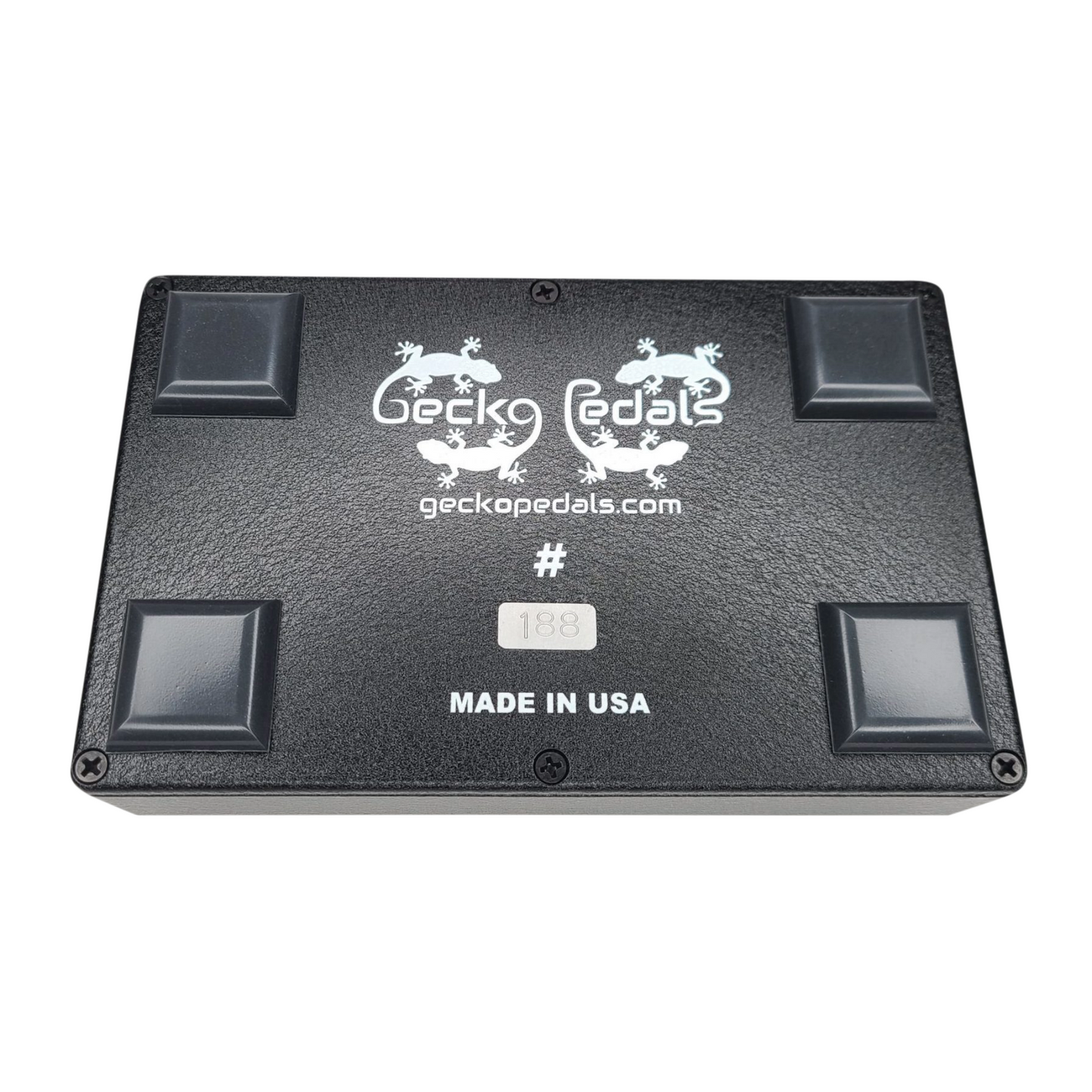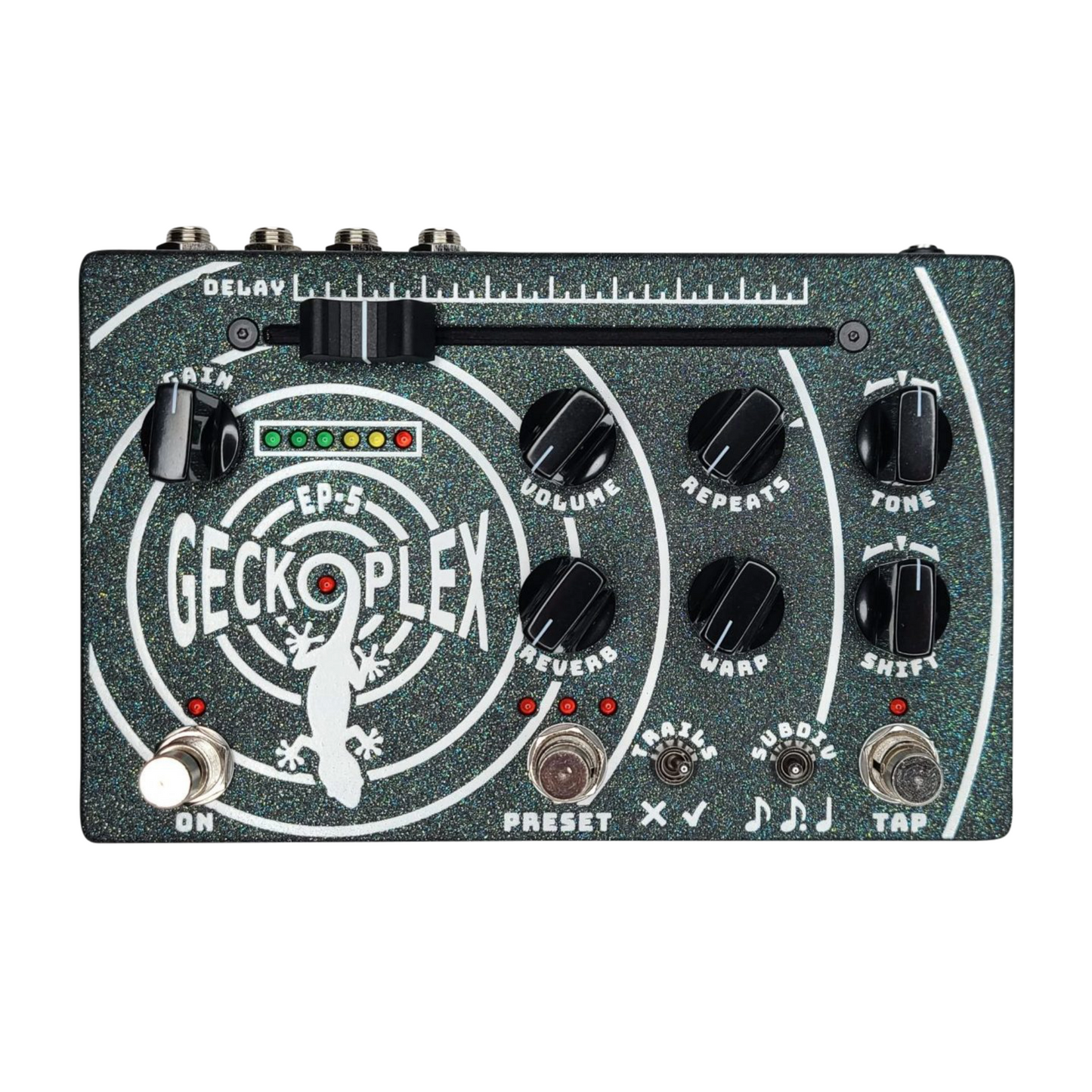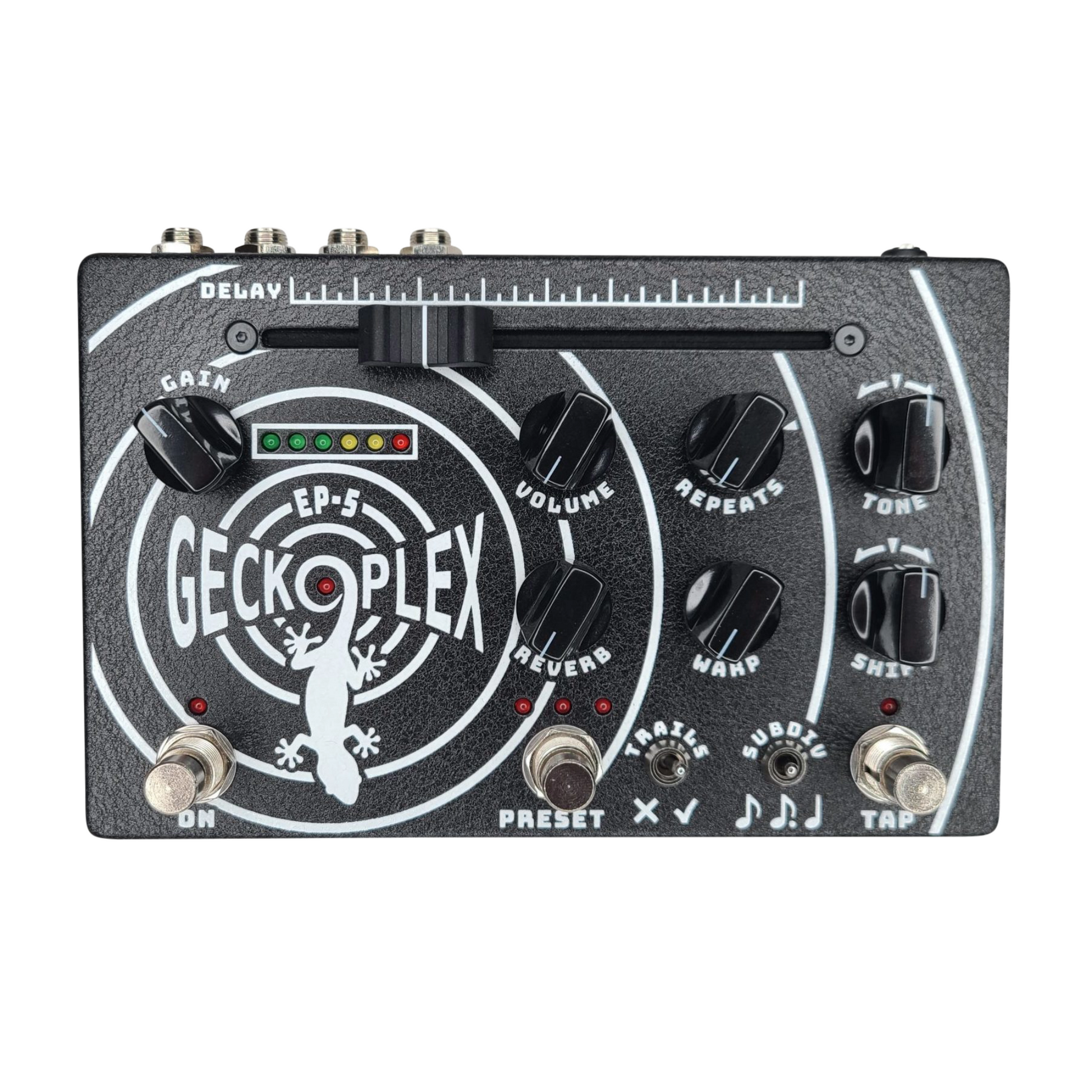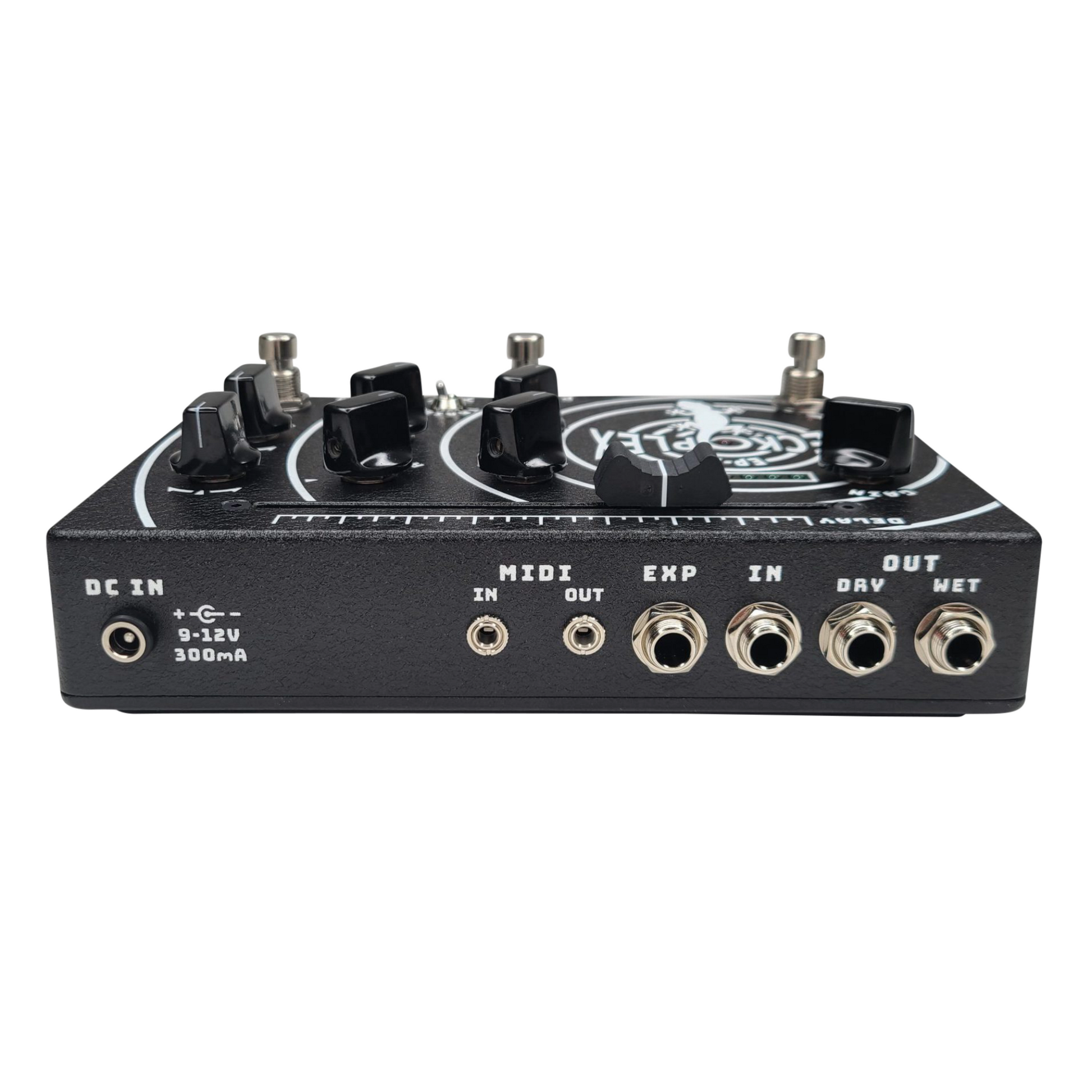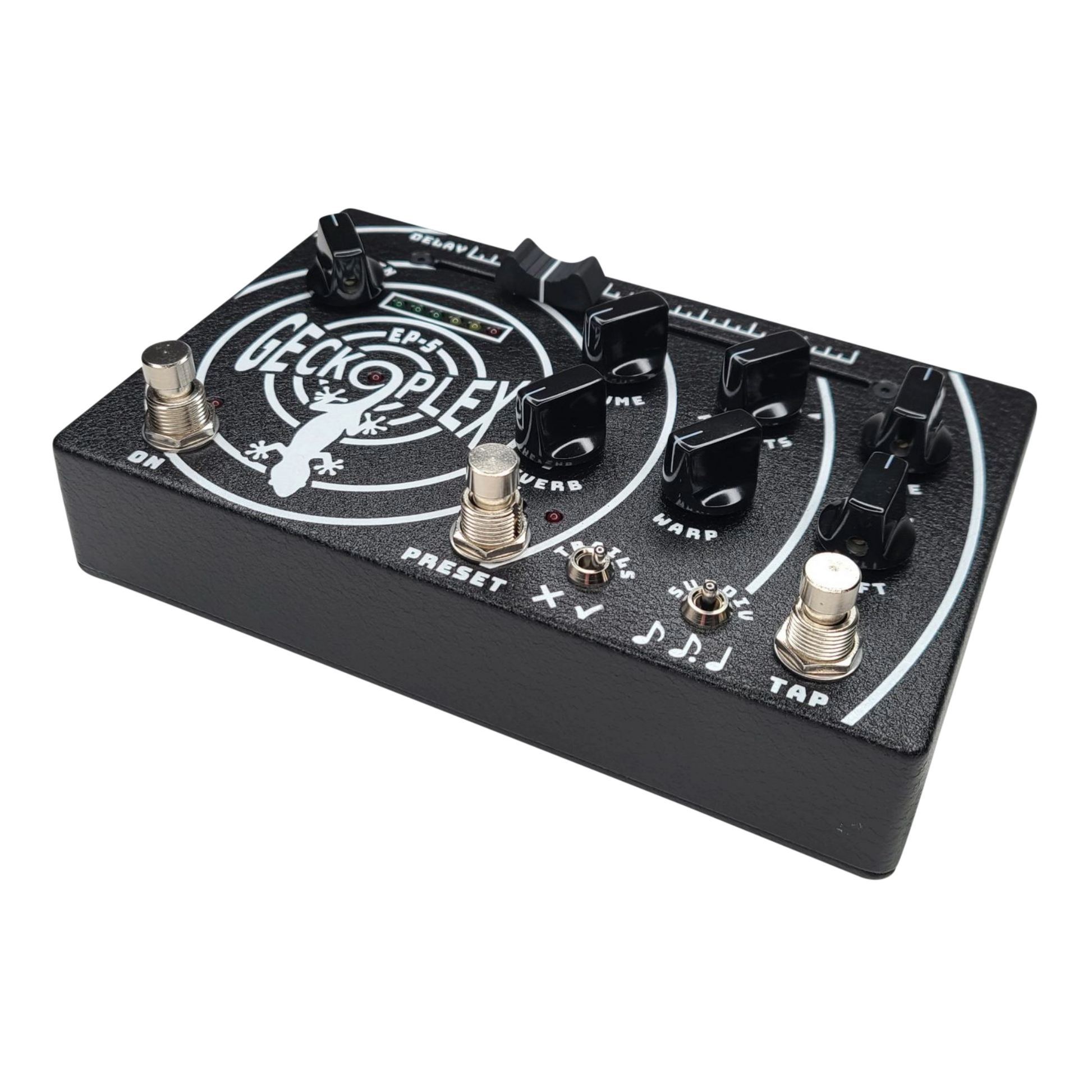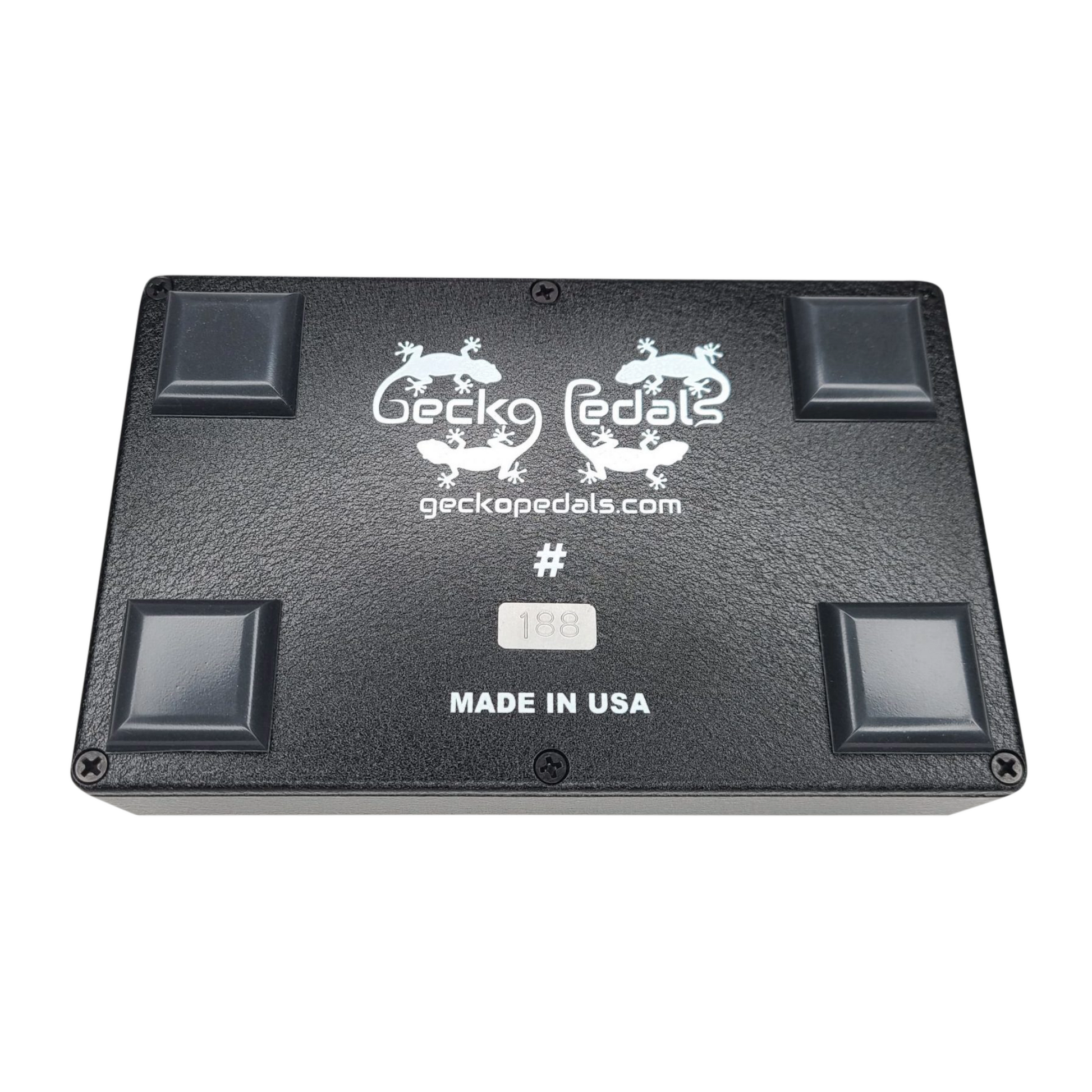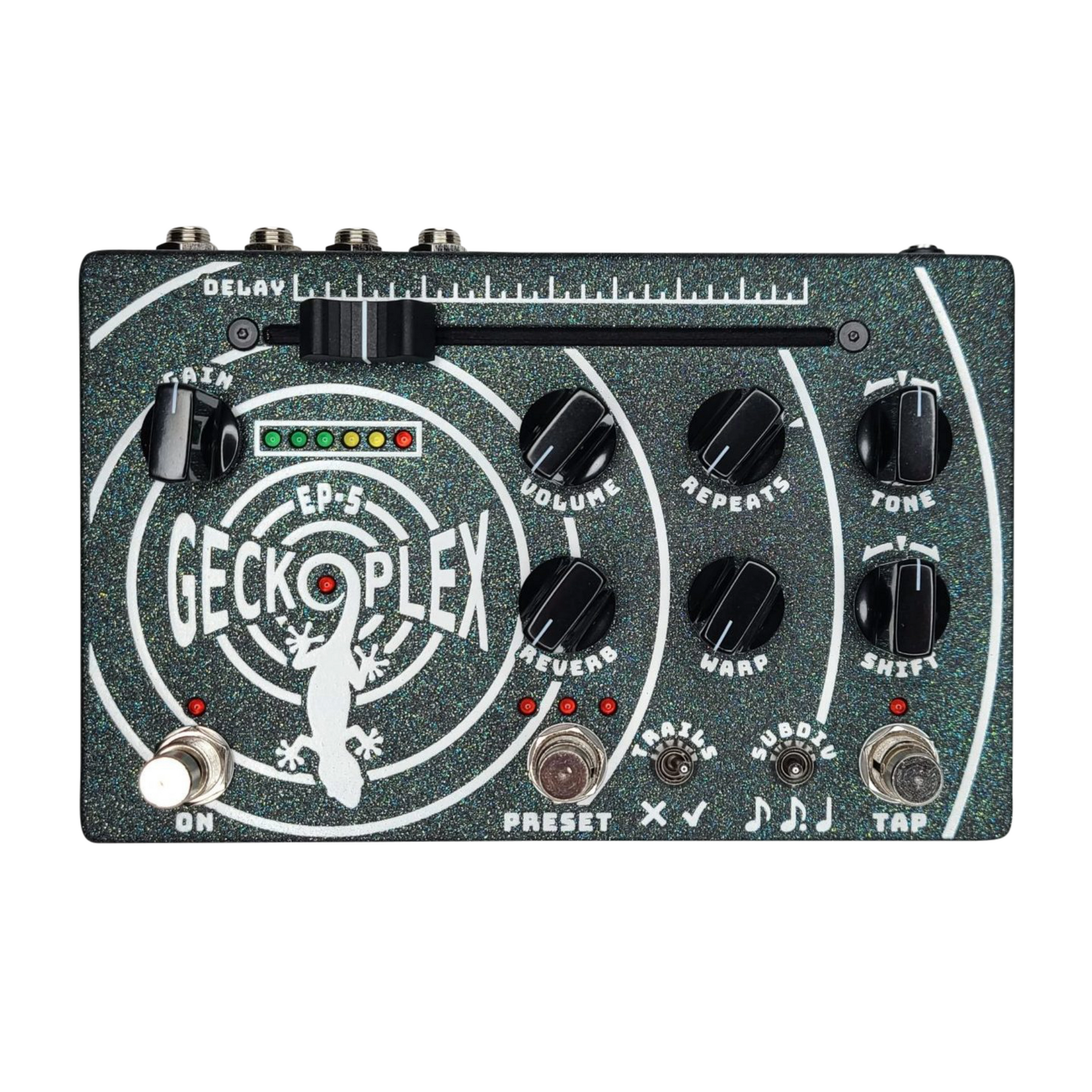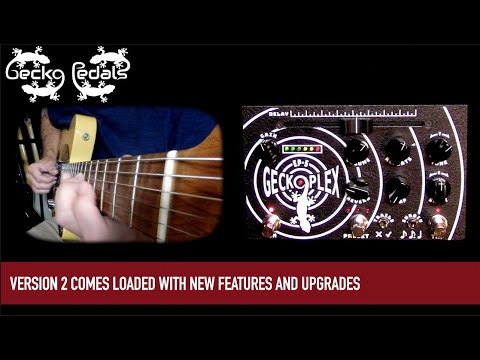Gecko Pedals
Geckoplex EP-5 V2
Geckoplex EP-5 V2
FREE 2Day Shipping
FREE 2Day Shipping
USA Free 2 Day Shipping
(Next Day in New England)
Canada NOW FREE!
Worldwide 30USD Flat Rate*(Wherever you are)
Flat Rate means no additional charge for more than one pedal.
No Hassle Returns
No Hassle Returns
Dimensions
Dimensions
Length: 9"
Width: 6.25"
Height: 3.625"
Specifications
Specifications
9 VDC center negative
Couldn't load pickup availability
The development of the Geckoplex took many years. Throughout this process was a constant drive to create a pedal that accurately maintained the sound and feel of a vintage tape delay machine, while also providing all the benefits of more modern equipment.
The monochrome artwork nods at the aesthetics of decades past, while nothing exemplifies the strive to preserve a vintage tape experience more than the delay slider. Several 1960's-1970's era machines set the delay time with a linear slide control that physically moved a tape head along a length of moving tape. The Geckoplex now brings back that same slide control format to a modern device.
As far as the sound, everything possible was done to accurately simulate the unique sonic characteristics of analog tape machines. The echoes are nicely compressed, just as they would be due to the effects of tape saturation. The warp control allows adding in varying amounts of tape elements, giving control over how much the echoes will degrade and “bloom” as they would from a more worn-in tape machine.
On top of the vintage sound and feel, the Geckoplex then adds on a number of modern conveniences. To start, unlike real tape machines, it is completely maintenance free! It is also fully MIDI controllable, has a tap tempo with selectable subdivisions, programmable presets, expression pedal support, Sound on Sound looping, and separate wet and dry outputs, all packed in behind a simple and easy to use interface.
To ensure the highest quality, each Geckoplex is manufactured, tested, and individually numbered by hand in Eugene, Oregon, USA. This commitment to quality additionally extends to the user experience. We truly hope you enjoy your Geckoplex as much as we did creating it, and that it serves you well for years to come. However, if for any reason you aren't completely happy with it, we want to hear about it. If you totally love it, we don't mind hearing that either.
GAIN controls the analog input preamp gain. The preamp is always on even when the ON switch is toggled off in order to maintain a constant signal level. The setting can affect the echo saturation somewhat, but for the most part this control has little influence on the effects. The 1:1 gain position is with the knob around 10:00 to 11:00, or roughly pointing just before the G in GAIN. Above this point the signal will be amplified up to a maximum of +11dB. The gain should be lowered if other pedals in the chain don't function properly with a boosted signal, or if the red “peak” light on the level meter is being reached.
VOLUME controls the output volume of the echoes. With the knob turned all the way to the left, echoes will be silenced. With the knob turned all the way to the right, the initial echo volume will be louder than the input volume. NOTE: This does not affect the Reverb output volume. Reverb is controlled independently with its own dedicated knob.
REPEATS controls how much echoes will continue to repeat, fading more quickly the more the knob is turned to the left. The marker at about 2 O'Clock indicates the runaway feedback point, or “self-oscillation point”. With the knob turned clockwise past this marker, the repeating echoes will grow in volume rather than fade.
TONE controls the Bass/Treble tone of the echoes. The marker indicates the center neutral point. With the knob pointing straight up, the echo sound will be unchanged. With the knob to the left of center, the echoes will sound warmer, with more bass and less treble. With the knob to the right of center, the echoes will sound brighter, with more treble and less bass.
REVERB adds a reverberation effect, making the output sound like the instrument is being played inside of an echoing chamber or large hall. This effect is controlled separately from the echoes, and a reverb-only effect is possible by turning up the REVERB while turning the VOLUME knob all the way down.
WARP controls how tape-like the sonic qualities of the echoes are. With the knob turned all the way down to the left, echoes will sound clean and pristine, able to repeat nearly endlessly without changing much. With the knob between 9:00 and the midpoint, echoes will have the sonic qualities of those produced by a well-tuned tape machine, with each new echo blooming into a more “washed-out” sound. With the knob up past the midpoint, the echoes will begin sounding as they would sound coming from a tape machine in need of a tune-up, being more wavering, fluttering, and gritty.
SHIFT controls how much delay “shift” is applied when a note is played. This unique effect mimics the user shifting the delay slider back and forth at the same time that a note is played, causing the echoes to “shift” in pitch down and back up, or up and back down, depending on the knob direction. The marker indicates the center neutral point where no shift occurs. How far the knob is moved away from center determines how much the delay is shifted left or right when a note is played.
The Geckoplex includes a Sound on Sound (SOS) mode that allows looping playback of up to 40 seconds of recorded audio.
-
Full MIDI control, with up to 64 MIDI accessible presets, clock sync, and clock master mode.
- Can be fully bypassed. The off-state output modes are user selectable(buffered with preamp active, or fully bypassed).
- User selectable max delay time (650ms, 1sec, 2sec).
-
User selectable expression pedal functions in the Sound on Sound looper mode (playback volume, playback speed, or loop degradation).
- Independent control of reverb parameters via MIDI (mix, decay time, tone).
- Over 2X higher headroom before clipping.
- Even lower overall noise floor.
- Analog FET input preamp gain stage, with level adjustable from zero up to +11dB by the GAIN knob.
- Super high quality 24bit/96kHz audio digital audio in the effects path.
- Up to 2 seconds max delay time.
- Sound on Sound (SOS) looper mode, with loops of up to 40 seconds.
- Toggle switches change the SOS loop playback speed and direction (1/2, normal, 2X speeds, and backward or forward playback).
- Separate WET/DRY outputs for use with dual amp setups or other non-conventional signal routing.
- The dry signal can be switched off on the wet output for pure WET/DRY outputs (internal switch).
- 3 (or up to 64 accessible by MIDI) Fully programmable presets, with seamless switching between them.
- Expression pedal support, allowing full control of any set of controls over any desired range on each preset.
- Tap tempo with selectable subdivisions (eighth note, quarter note, and dotted eighth note subdivisions).
- Tap tempo hold function ramps up into temporary self-oscillation.
- TRAILS toggle switch to control whether trailing effects are heard after the unit is switched off.
- Buffered outputs, capable of easily driving amps with clarity, even through long cables or into Lo-Z inputs.
- Motorized delay slide control to set the delay time, similar to a tape write head position lever found on some vintage tape delay units.
- 6 effect control knobs: echo VOLUME, REPEATS, TONE, WARP, REVERB, and a Gecko Pedals original effect: SHIFT.
- LED level meter bar with peak indicator (6 LEDs).
- A preposterously powerful ARM Cortex M7 core handles the DSP heavy lifting.
- The enclosure is powder coated and artwork is printed with epoxy ink for ultimate finish durability.
- Gold-plated contacts on the circuit board (ENIG finish).
- Real genuine Davies Molding knobs, made in Chicago, USA
- Real genuine Hammond Manufacturing all metal enclosure.
- Only polyester film and ceramic capacitors are used throughout. No electrolytic or tantalum capacitors to worry about drying up or otherwise failing.
- Polyester film capacitors are used exclusively in the audio signal path.
- Silicone wire cable assemblies are used for all peripheral circuit board connections.
